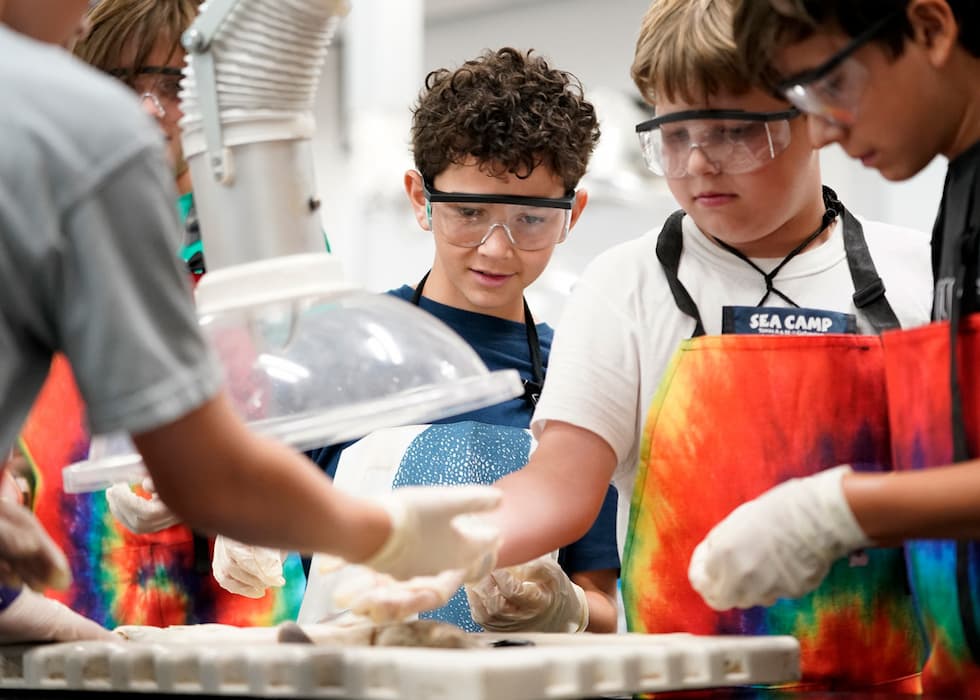Sea Camp Encourages Lifelong Learning
September 13, 2023
Tweet
By Taylor Bounds
As the fall semester starts and summer comes to a close, faculty, staff and students alike are gearing up for the new school year. However, there is no summer lull at the Galveston campus, where activity buzzes all season long in the Sea Aggie Center and beyond because of one of the largest outreach programs at Texas A&M University at Galveston.
Every summer, the campus welcomes over 1,000 students of all ages to experience the unique and hands-on educational marine opportunities of Sea Camp. Sea campers range in age from 4-18 in a variety of programs: Sea Squirts, for children ages 4-5 and their parents, Sea Campus Kids, a day camp for students aged 6-11, and Sea Camp, an overnight camp for students aged 10-18.
Tara Donnelly ‘23, a former sea camper who graduated in May with her bachelor’s degree in Maritime Studies, spent last summer as a Sea Camp counselor. The Galveston local says her relationship with the campus started the summer after kindergarten, when she first attended Sea Camp.
“I remember coming home with a pound of sand in each shoe at the end of the day,” said Donnelly. “I loved being able to walk around the island and identify all of the plants and animals that I learned during camp.”
During her college decision process, Donnelly considered schools in both Texas and Louisiana, but wasn’t sure which direction she wanted to go. As many juniors and seniors in high school can attest, juggling classes, admissions and scholarships is stressful at best, and to compound that, none of the universities Donnelly visited felt right—until she visited the Galveston campus as a prospective student. From her experience with Sea Camp, she knew that “there were good people here and that the campus was filled with opportunities,” and after a campus tour with her family, she knew she had found the school for her.
Donnelly is now a Maritime Business Administration and Logistics graduate student, and looks forward to starting classes for her master’s degree this fall. She interned with the Galveston Island Park Board of Trustees, giving her an in-depth and hands-on understanding of the island’s tourism industry, and upon completion of her master's degree, plans to work in port operations in the coastal tourism industry.
During her internship, she had the opportunity to interview Theresa Morris ‘10, ‘13, the Program Coordinator for the Gulf Center for Sea Turtle Research (GCSTR) and another Sea Camp alumni, as part of the board’s Women in Coastal Science speaker series. At GCSTR, Morris oversees the program’s large volunteer base, coordinates with veterinarians, and treats the sea turtle patients for eventual release back into the wild, or to a forever home.
Another former camper, Christena Hoelscher ‘19, ‘21 originally attended Sea Camp as a gift from her grandparents, but decided on her first day that she wanted to attend the Galveston campus for her degree.
“Sea Camp was foundational to my higher education experience,” said Hoelscher. “After my first camp, I started telling people ‘there’s this university that studies the ocean and that’s where I’m going to college.’ I instantly fell in love with the campus.”
When it came time to apply, Hoelscher said that while she considered other schools, including Texas A&M’s campus in College Station, it was mostly “just for giggles” to humor her mom, but ultimately knew that the Galveston campus was the right choice for her.
Now a staff geoscientist for Fugro, Hoelscher spends a few months offshore a couple of times a year collecting sediment cores from the middle of the ocean. Joking that she “gets paid to play with mud,” when shoreside, she tests the core samples for potential geohazards in the energy sector.
Since 1986, Sea Camp has inspired generations to study and pursue careers that start at Texas A&M - Galveston. The camps introduce students to research, field work, laboratory settings and the campus as a whole, and its impact continues to be felt across campus and marine and maritime industries.
Donnelly, Morris and Hoelscher all agree: Sea Camp is for everyone.
###
Media contact:More:
Read more about Health & Environment
Read more about Science & Technology
Read more about Foundational Sciences
Read more about Marine Biology
Read more about Marine Sciences